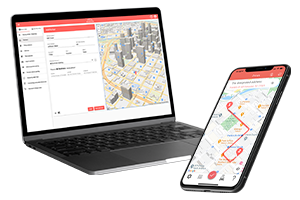Last updated: April 12, 2024
Becoming a Lyft driver gives you a flexible way to earn income, but it also comes with responsibilities that you must be prepared for.
So where do I start?
In this article, we will explore the vehicle requirements and provide basic information on Lyft drivers’ taxation. Whether you’re new to Lyft or considering joining, this summary will give you an easy start on your new gig.

Vehicle Requirements and Inspection
For your car to be eligible for driving, your vehicle must meet Lyft’s vehicle requirements. These rules ensure quality service and the safety of both drivers and passengers.
Let’s review Lyft’s vehicle standards!
Your car must adhere to certain criteria to pass the Lyft vehicle inspection. These can vary in different areas, but they typically include:
- Age: Your vehicle cannot surpass the model year requirement of your area, which is usually no more than 10-15 years,
- Seats and doors: It must have at least four doors and a minimum of five seatbelts (but not more than eight) including the driver’s seatbelt,
- Condition: It should be free from significant visible damage and comply with all applicable city or state safety requirements.
Lyft also has a program that helps you rent a car to start driving. This is a good solution for those who do not own a car or are simply looking for the best cars for Lyft. These cars still need to go through the Lyft car inspection.
Inspection Locations and Process
Finding a Lyft inspection location is quite straightforward. Lyft provides a list of approved sites, including Lyft hubs and certified third-party mechanics. This helps you find a Lyft vehicle and car inspection location near you.
Unlike other similar companies, Lyft does not offer free car inspection. During the examination, various vehicle components such as brakes, lights, tires, and windows will be checked to ensure compliance.
Tax Responsibilities of Lyft Drivers
Moving on to tax responsibilities, it’s important for Lyft drivers to understand their classification and obligations. As a Lyft driver, you’re classified as an independent contractor. This classification affects how you’ll manage and pay your Lyft taxes. Instead of the W2 form for employees, you will have to fill out the 1099 form issued by Lyft.
What is the 1099 form?
The 1099 form is the tax document used by Lyft to report your earnings to the IRS. Unlike in the case of traditional employment, as an independent contractor your taxes aren’t withheld from your payments, so meeting your tax obligations will be your responsibility, which include:
- Self-Employment Tax: Covering Social Security and Medicare,
- Income Taxes: Both federal and state, depending on your earnings and location.
How to Maximize Your Tax Deductions
Many people are not familiar with the tax deductions they are eligible for. It would be a grave mistake to miss out on a chance of saving money! Just a few expenses that you might want to record for tax deduction:
- Lyft fees and commissions,
- Snacks and refreshments for passengers,
- Personal protective equipment, such as masks or hand sanitizers,
- Accessories and equipment, like chargers, mounts, car tool kits, first aid kits or tire inflators,
- Vehicle expenses and miles driven.
Let’s delve into the deduction of vehicle expenses and mileage.
When it comes to tax reimbursements for travel, one must have precise documentation of either miles traveled, or travel expenses. These reflect the two primary options: the standard mileage method and the actual expense method.
The standard mileage method allows taxpayers to deduct a specified amount for each mile driven for business purposes, as determined by the IRS standard mileage rate. This rate typically includes all vehicle-related expenses such as gas, repairs, maintenance, insurance, and depreciation.
On the other hand, the actual expense method involves itemizing all of the above-mentioned vehicle-related expenses incurred during your rides.
While both methods have their merits, the standard mileage method is often favored for its simplicity and potential for larger deductions. This method generally provides larger tax write-offs than itemizing all vehicle-related expenses individually, especially when using the standard mileage rate of the IRS. It offers a straightforward way to calculate deductible mileage without the need for detailed record-keeping of individual expenses.
Let’s review the options one should consider to have an IRS-proof monthly mileage log:
For Lyft drivers looking to maximize their tax deductions and lower their income tax, using a tax-purpose mileage tracker app is a practical way to track miles accurately and efficiently. These apps automate the mileage tracking process, eliminating the need for manual mileage logs such as paper-based tracking or software-based sheets, thus reducing the risk of errors or discrepancies that could trigger an IRS audit. Furthermore, this not only ensures accurate reimbursement but also simplifies expense tracking for businesses, improving overall financial management and compliance.
In summary, the standard mileage method, coupled with the use of a mileage tracker app will make the best Lyft tax calculator.

MileageWise: The IRS-proof mileage log for IRS audit
The IRS can ask for the mileage log of the year it audits. When this happens, it will review the log’s compliance with the IRS requirements. Whether you choose daily tracking or to reconstruct your mileage logs with the built-in IRS auditor, the App will provide exceptionally precise data that is guaranteed to meet the criteria of the IRS screening.
Why Mileagewise?
Mileagewise has several helpful tools that will make tracking your miles and expenses a walk in the park:
- Low-effort mileage tracking
Unlike basic mobile apps or using a pen and paper, Mileagewise offers several solutions tailored to every user’s needs. Just turn on automatic tracking and let MileageWise deliver your mileage log to you. Gone are the days when you had to continuously worry about forgetting to log your trips.
- IRS-Proof log
The IRS has distinct requirements concerning a mileage log. Mileagewise guarantees to provide precise and complete information needed for your log, minimizing the risk of complications and potential audits. Its built-in AI algorithm even checks and corrects up to 70 possible logical contradictions to ensure that the final report is 100% IRS-Proof!
- Access your data anytime, anywhere
Mileagewise is cloud-based, so you can access your mileage log from any device. This flexibility is particularly helpful for Lyft drivers who are always on the go and might need to check or update their logs from different devices.
- Four distinct recording modes
MileageWise offers four recording modes: vehicle movement tracking, Bluetooth monitoring, Plug’N’Go monitoring, and manual input. You can also set the days and time periods you want to track. For example, you can choose to automatically log miles only during weekdays and working hours.
- AI Recommendation Wizard
This tool identifies inconsistencies and gaps within your log and provides recommendations to fix them, making your log complete and as accurate as possible.
- Automation to save time
Lyft drivers already have a lot on their plates, from finding the right time and location to granting quality experience for their customers. Save time with automation features like the Trip auto-classification, or the Standby-timer, so you can focus on the tasks at hand instead of logging.
- Low-effort mileage tracking
Join the MileageWise community today!
Sit back and let Mileagewise handle your mileage tracking! Save time, reduce possible errors, and enjoy the benefits we offer.
Download MileageWise’s automatic mileage tracker app from Google Play or the App Store & try it for free for 14 days. No credit card is required!
| MileageWise | TripLog | MileIQ | Everlance | Driversnote | SherpaShare | Hurdlr | Excel | |
User Ratings (Trustpilot) | N/A | N/A | N/A | |||||
iOS App User Ratings | ||||||||
Android App User Ratings |
| |||||||
Average Possible Business Mileage Deduction | $12,000 | $6,300 | $8,400 | $6,500 | $6,000 | $5,600 | $5,600 | $200-$2,000 |
Imports Trips and locations from Google Timeline | ||||||||
Produces IRS-Proof Mileage Logs | ||||||||
Creates Retrospective Mileage Logs | ||||||||
AI Wizard Technology for Mileage Recovery | ||||||||
| Sampling / Recurring Daily Trips | ||||||||
| Mass Distance Calculation | ||||||||
| Built-In IRS Auditor for 70 Logical Conflicts Correction | ||||||||
| Web Dashboard | ||||||||
| Mileage Tracker App | ||||||||
| Vehicle Expense Tracker | ||||||||
| Manual Trip Recording | ||||||||
| Bluetooth Auto Tracking - with no hardware needed | ||||||||
| Plug'N'Go Auto Tracking | ||||||||
| Vehicle Movement Monitoring | ||||||||
| Battery and Data Friendly | ||||||||
| Other Software Integrations | ||||||||
| Trip List Import from other Mileage Trackers | ||||||||
| Trip List Import from GPS | ||||||||
| Shared Dashboard for Teams | ||||||||
Features are all related to mileage tracking | ||||||||
Pricing | Price list | Price list | Price list | Price list | Price list | Price list | Price list | Price list |
Lorem ipsum dolor sit amet, consectetur adipiscing elit. Ut elit tellus, luctus nec ullamcorper mattis, pulvinar dapibus leo.



